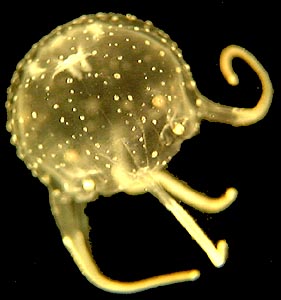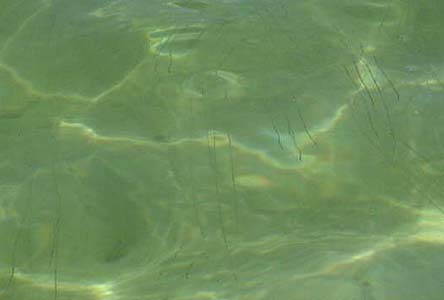|
Cubozoans are voracious predators.
Many jellyfish and other
gelatinous animals go unnoticed by those who visit the ocean.
Like this "herd" of cubozoans in the picture above, gelatinous animals
are often difficult to see.
However, they are important members of marine
ecosystems. For instance, box jellies are known to eat
fish,
worms, and crustacean
arthropods. When the tentacles,
which can stretch to ten or more times the
height of the bell,
come into contact
with prey, nematocysts fire into the prey's skin.
Tiny barbs of the nematocysts hold onto and transfer venom to the prey.
As the prey is immobilized by the venom, the tentacle contracts and pulls the
prey near to the bell. Then, an amazing thing occurs. The muscular
pedalium bends and pushes the tentacle and
prey into the bell of the medusa. The manubrium
then reaches out for the prey and the mouth
expands and engulfs it. The entire feeding process is relatively fast,
taking place in as little as one minute. Cubozoans are not quite at the top
of the food web, as they are sometimes eaten by large fish and sea turtles.
Cubozoans are active and agile swimmers.
Jellyfish are typically referred to as planktonic, meaning that their swimming
is not strong enough to prevent them from drifting with currents. As a
consequence, many jellyfish wash up on beaches.
However, box jellies are very rarely found on
beaches. This is because they are unusually strong swimmers. It has been reported
that large specimens of Chironex fleckeri can
swim as fast as two meters in one second. However, that speed has not been confirmed.
Cubozoans (of various sizes) have commonly been observed to swim a meter
in five to ten seconds. Presumably, cubozoans use strong muscles, as well as the
Velarium, to achieve these speeds. Not only are
cubozoans fast, but they are remarkably agile. They have been reported to maneuver
around the pilings of peers and to flee would be human collectors. These behaviours
can only be achieved because cubozoans have vision.
Few experiments have been tried in order to determine how well cubozoans can see,
but it is clear that they can see well enough to avoid swimming into things and
being captured. It is also likely that they can see eachother, which might help
explain some interesting observations about their mating.
 Cubozoan Life Cycle
Cubozoan Life Cycle
Some species of cubozoans appear
to pair up, male with female, in order to mate. The male puts his tentacles
into the bell of the female and appears to pass packets of sperm.
At least one other species has been observed in large mating aggregations.
Mating appears to occur once every year. Fertilization takes place inside
the females. In some species the fertilized eggs are released into the water
column where they develop into planulae, while
in others development into planulae occurs inside the female. Planulae swim in
the water column for a few days and then settle on to the substrate. After
settlement, the planulae grow into polyps. The
polyps can move around, and they frequently bud off additional polyps. After a
few months of feeding, the polyps are mature. Then, each polyp metamorphoses
into a single juvenile medusa (above right). During metamorphosis, the polyp
tentacles are resorbed and four new tentacles and four
rhopalia are formed. With a couple of contractions,
the entire individual becomes detached and swims away as a juvenile medusa.
|












